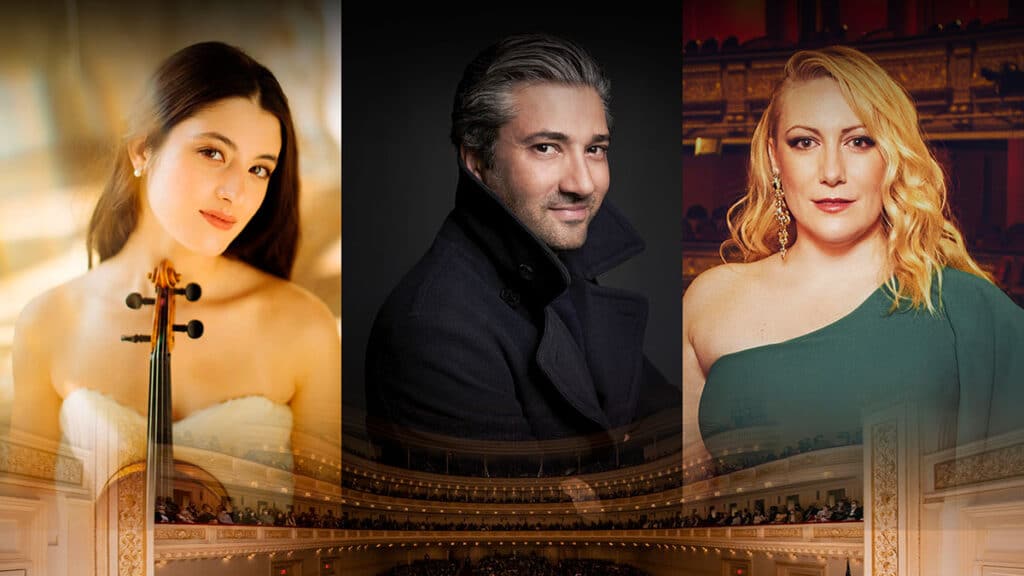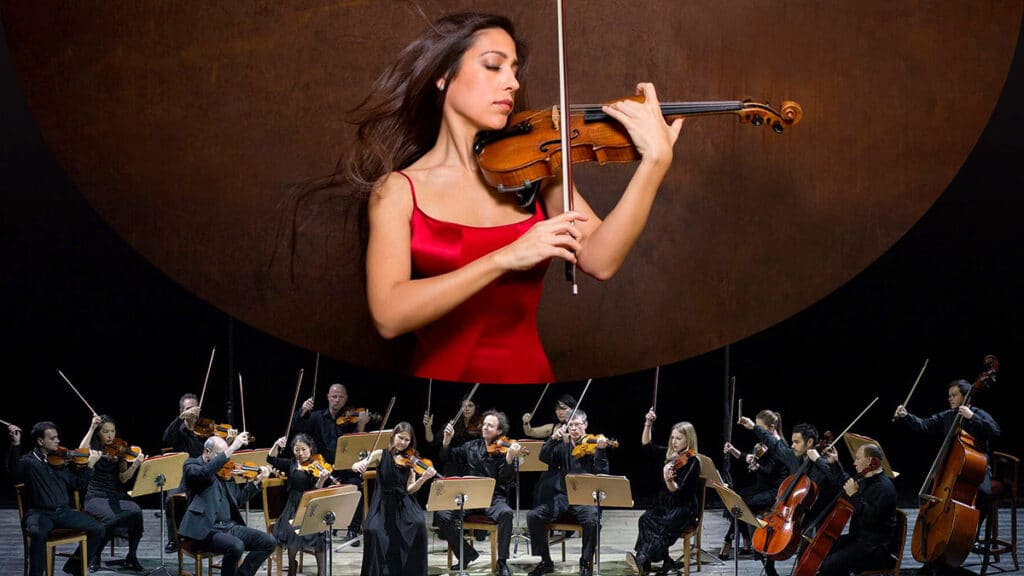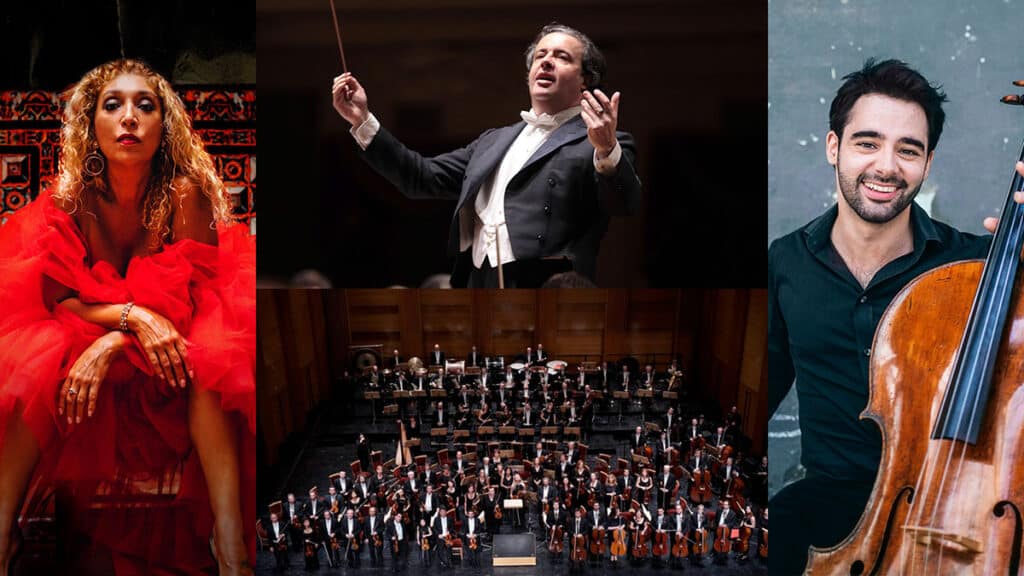
Teatro Real, The Royal Opera of Madrid is Spain’s national opera and orchestra, and one of the country’s most respected cultural institutions.
Thank you Teatro Real for sponsoring classical music in New York Latin Culture Magazine.
Teatro Real Musical Fantasy From Spain Gala
Teatro Real, the Royal Opera of Madrid Orchestra, plays a gala musical fantasy of Spain featuring violinist María Dueñas and soprano Saioa Hernández, conducted by David Afkham; on the Stern Auditorium / Perelman Stage at Carnegie Hall in Midtown, Manhattan; on Thursday, June 5, 2025 at 8:30pm. From $26.50. carnegiehall.org 🇪🇸
These are world-class artists backed by a world-class orchestra.
María Dueñas is a Spanish violinist and composer from Granada, Spain. The first prize winner at the 2021 Yehudi Menuhin Competition and 2024 Opus Klassik award winner for Young Artist of the Year is already one of the most famous Spanish violinists internationally. Known for her collaborations with Venezuelan conductor Gustavo Dudamel, she records for Deutsche Grammophon, the renowned classical music label. mariaduenasviolin.com 🇪🇸
Soprano Saioa Hernández is a Spanish operatic soprano from Madrid who is making her American debut at Carnegie Hall no less. She became famous internationally for performing Odabella in Verdi’s “Atilla” at La Scala, the renowned Milan opera house in 2018. saioahernandez.com 🇪🇸
David Afkham is a conductor from Freiburg im Breisgau, Germany. He is the Chief Conductor and Artistic Director of the Spanish National Orchestra and Chorus. davidafkham.com 🇩🇪
The program includes:
- TURINA Danzas fantásticas 🇪🇸
- KORNGOLD Violin Concerto 🇦🇹
- RAVEL Alborada del gracioso 🇫🇷
- FALLA “¡Allí está! Riyendo junto a esa mujé” from La vida breve 🇪🇸
- FALLA “Danza No. 1” from La vida breve 🇪🇸
- PENELLA “Juntos desde chavalillos” from El gato montés PENELLA
- SERRANO “¿Qué te importa que no venga?” from Los claveles 🇪🇸
- RAVEL La valse 🇪🇸
Teatro Real The Eight Seasons of Vivaldi and Piazzolla

Teatro Real (Royal Opera of Madrid) led by award-winning violinist Leticia Moreno and renowned soloists from the Teatro Real Orchestra, pairs Vivaldi’s “The Four Seasons” with Astor Piazzolla’s “Four Seasons of Buenos Aires” for an elegant night of classical music and tango jazz; at Carnegie Hall’s Zankel Hall in Midtown, Manhattan; on Wednesday, June 26, 2024 at 6:30pm. From $39 + fees. carnegiehall.org 🇪🇸 🇦🇷 🇮🇹
A VIP Rooftop Reception with the artists is available as a limited availability add-on to the concert ticket. It’s a wonderful opportunity to meet Leticia Moreno and soloists from the orchestra.
This is a clever pairing because both Vivaldi and Piazzolla changed their respective musical forms, and we all respond to the changing of the seasons.
Seasons mark the passing of time, and each has a unique emotional tone. Spring is warm and full of birdsong that reminds us life is full of possibility. Summer is hot and when it rains it pours. After the Autumn harvest, people have more time for festivals, and hunters look to fill their storerooms with meat. Winter cold seems to draw the life out of us, so we huddle indoors to wait its passing. You can hear all of these emotions in both compositions.
The Four Seasons
Antonio Vivaldi’s “The Four Seasons” (“Le Quattro Stagioni,” 1723-25) is one of classical music’s most recognizable works. The four violin concertos marked a transition from baroque to classical tradition (as in Baroque > Classical > Romantic > Modern).
Vivaldi is considered the inventor of the solo concerto. This entirely new orchestral format with solo violin, string quartet, and a harpsichord or organ; offered a call and response between the soloist and orchestra.
The work also marked a transition into “program music,” or music that tells a story. In a way it was film music, long before film even existed. That may be one of the reasons “The Four Seasons” is so popular. It takes you on a journey.
The piece has become associated with four sonnets. It’s not clear whether Vivaldi wrote them, or wrote the music to the sonnets, or someone wrote the sonnets to the music, but there it is, a narrative. The music and sonnets go together really well. To really enjoy this concert, it’s worth reading the sonnets on wikipedia.org (Español ~ English). Do you hear the same story the author did?
The Four Seasons of Buenos Aires
Piazzolla composed “Cuatros Estaciones Porteños” (The Four Seasons of Buenos Aires) in 1969. “Porteños” are the people of Buenos Aires, Argentina’s main port city. The composition is a clear reference to Vivaldi’s work.
Astor Piazzolla changed Argentine tango forever with his “nuevo tango” (new tango), when he infused Argentine tango with classical and jazz traditions. Piazzolla actually started playing the bandoneon as a young man in New York City when his father found one in a pawn shop. Jazz Age New York was where Astor was exposed to American jazz. The connection actually makes sense because both tango and jazz are creations of the African Diaspora in the Americas.
Genius often shows early and Piazzolla’s natural talent was quickly obvious. Carlos Gardel, the iconic tango singer, heard the young man play and invited him on tour. Astor’s father wouldn’t let him go. It’s a good thing because Gardel died when his plane from New York crashed while landing in Medellín, Colombia.
In Buenos Aires, at Arthur Rubenstein’s suggestion no less, Piazzolla studied with Alberto Ginastera, one of the great classical composers of the Americas. In Paris, he studied with Nadia Boulanger, one of the most influential women in classical music. She was the master teacher of many renowned artists. Astor kept leaning into classical music, but his teachers kept pushing him back towards the tango.
When Piazzolla started performing his tango nuevo in Argentina in the 1950s, Argentines didn’t like it at all. They said it wasn’t tango. Today, Piazzolla’s nuevo tango style is the dominant form. It’s what most people think of when they think of tango. Even modern club tango builds on Piazzolla’s nuevo tango. Astor composed his seminal work “Adios Nonino” as an adult while back in New York City in 1959. In several ways, Piazzolla’s work is New York City music too.
Leticia Moreno
Leticia Moreno is a Spanish violinist of Peruvian descent. The child prodigy is now a soloist with symphony orchestras around the world.
Greatness in classical music doesn’t come from just playing the music correctly as written or in a period style. Many artists do that, but great ones like Leticia Moreno make their audience feel the music. She is a very passionate violinist who will make you feel each of the eight seasons.
The Eight Seasons
Vivaldi’s “Four Seasons” plus Piazzolla’s “Four Seasons of Buenos Aires” makes eight. Four seasons from the old world and four from the new. Four seasons from the north and four from the south. Separated by time and distance, this program ultimately shows how we are all connected in this incredible journey called life.
Teatro Real Gala Concert: From Spain to New York Plays Falla, Dvořák, Ginastera, and Ravel at Lincoln Center
Teatro Real, The Royal Opera of Madrid, returns to New York with a symphonic and vocal Gala Concert: from Spain to New York. Juanjo Mena conducts the Orchestra of the Royal Opera of Madrid in Falla’s “El amor brujo” with flamenco singer Esperanza Fernández, Dvořák’s “Cello Concerto” with soloist Pablo Ferrández, and works by Argentine composer Ginastera and French composer Ravel; in the Wu Tsai Theater at David Geffen Hall in Lincoln Center; on Monday, October 16, 2023 at 8pm. From $30. lincolncenter.org 🇪🇸 🇦🇷 🇫🇷
If you like Spain, grand symphony orchestras, and opera, you will love this concert.
The Artists

Juanjo Mena
The Spaniard is a principal guest conductor with the Orquesta Nacional de España.
Esperanza Fernández
“The Voice of Flamenco,” is a renowned flamenco singer from Seville, Spain, the capital of the flamenco heartland. Her 2008 album “Recuerdos” was nominated for the “Best Flamenco Album” Latin Grammy. @esperanzafernandez_oficial
Pablo Ferrández
The cellist was the first Spaniard to win at the International Tchaikovsky Competition. pabloferrandez.com | @pabloferrandez.cellist
The Music
This is largely a concert of the work of Spanish composer Manuel de Falla and composers that he influenced.
Manuel de Falla “El Amor Brujo”
Manuel de Falla (1876-1946) was an Andalusian Spanish pianist and composer. He was one of the most important Spanish composers of the 20th century. He spent part of his working years in Paris and Buenos Aires, where he influenced other composers.
“El amor Brujo” (The Love Magician, 1915) is a ballet that is one of Falla’s most important works. This dramatic piece reflects Spain’s multicultural roots in the Spanish Romani people who breathed life into flamenco.
The work’s story is that an Andalusian woman Candela couldn’t be with her young love Carmelo because she was promised as a child to another. Her husband eventually died, but continued to haunt her every night. After talking with the village women, she realized that her husband was unfaithful with Lucía. So she invited Lucía to a hookup with her Carmelo, but instead her husband’s ghost took Lucía away, freeing Candela and Carmelo to be in love.
The most popular section is “Danza ritual del fuego” (Ritual Fire Dance). It was probably inspired in part by the Night of San Juan, a Spanish summer solstice tradition of jumping over bonfires three times to cleanse yourself.
Antonín Dvořák Cello Concerto
Antonín Dvořák (1841-1904) was a Czech romantic music composer who was inspired by the folk melodies of his native Bohemia (Eastern Czech Republic). He was the national master of Bohemian tradition. 🇨🇿
Dvořák wrote his Cello Concerto in B minor, Op. 104 in New York while he was director of the National Conservatory of Music in America in 1892-93. He was probably homesick because it is filled with bohemian feeling. The piece is one of the most beloved cello concerti.
Alberto Ginastera “Suite Panambi”
Alberto Ginastera (1916-1983) was an Argentine classical music composer, one of the most important Latin American composers of the 20th century. He studied briefly with Aaron Copland, and taught Ástor Piazzola. Ginastera is famed for his use of Argentine folk themes from gaucho culture. 🇦🇷
“Suite From Panambi” Op. 1a (1937), is an orchestral work based on a ballet he wrote in 1935. Panambí is a small town on the Uruguay River, along the border with Brazil.
Maurice Ravel “Daphnis et Chloé”
Maurice Ravel (1875-1937) was a French composer and pianist composer famed for his impressionist style. He was one of France’s greatest composers of the early 20th century. Though French, he was born in a Basque town near the Spanish border. Ravel is best known for his “Bolero” (1928).
Daphnis et Chloé, Suites No1 and No2M (1912) is a complex orchestral ballet. It was commissioned by Sergei Diaghilev’s Ballets Russes, the dance company that popularized ballet in the modern period. The story of the love between goatherd Daphnis and sheperdess Chloé, is considered Ravel’s orchestral masterpiece.
This is a truly regal Spanish concert.
Get tickets at from $30 at lincolncenter.org
Teatro Real, The Royal Opera of Madrid
The Royal Opera of Madrid was founded at Teatro Real (the Royal Theatre) in 1818. Opera Real at Teatro Real is like the Metropolitan Opera Orchestra at the Metropolitan Opera House. Both are their respective country’s leading symphony orchestras and classical music organizations.
The Teatro Real Foundation is led by the King and Queen of Spain, Felipe VI and Queen Letizia.
More Information
teatroreal.es
Instagram @teatro_real
Facebook @TeatroReal
X @Teatro_Real
TikTok @teatroreal
YouTube @TeatroRealOperaMadrid
